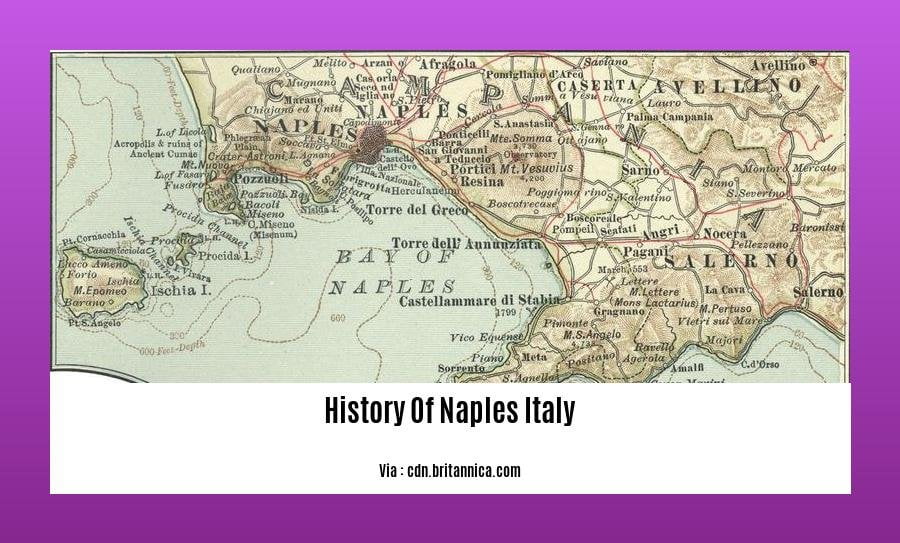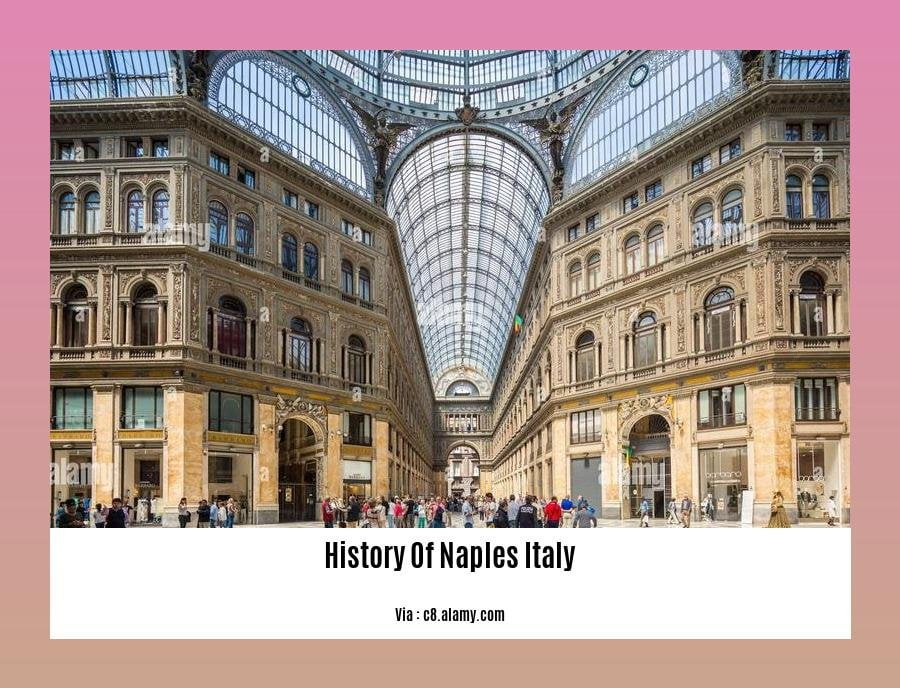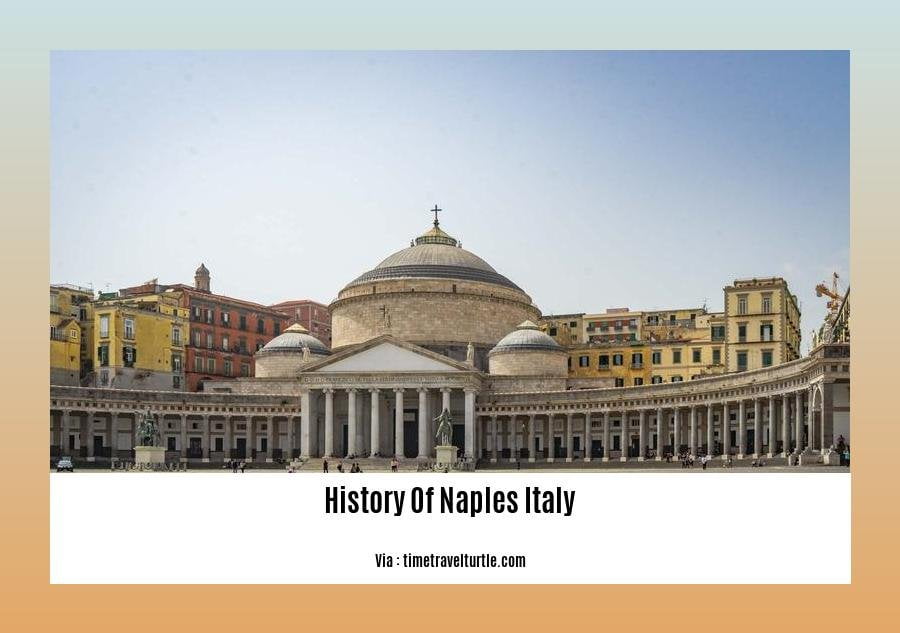With a history that dates back over 2,000 years, Naples, Italy is a city steeped in charm, intrigue, and unparalleled historical significance. From its humble beginnings as a Greek colony to its rise as a maritime powerhouse and the capital of the Kingdom of Naples, the city’s rich tapestry of past events has shaped its unique identity. Join us as we embark on a journey through time, unveiling the captivating history of Naples, Italy.
Key Takeaways:
Naples’ history dates back to the 2nd millennium BC with Greek settlements.
In the 8th century BC, a mainland colony named Parthenope was developed on the Pizzofalcone hill and later refounded as Neapolis in the 6th century BC.
Naples experienced rule under Norman, Hohenstaufen, Anjou, Aragonese, and Spanish before becoming part of the Italian Republic.
Naples played a crucial role in Italy’s unification during the Neapolitan War, rebelling against the Bourbon monarchs.
History of Naples Italy: A Journey Through Time

Naples, the vibrant capital of southern Italy, boasts a rich and captivating history dating back to the ancient Greek settlements. Unearth the layers of this alluring city’s past as we embark on a historical odyssey that weaves together myths, conquests, and cultural treasures.
Greek Roots and Roman Splendor
In the 2nd millennium BC, Greek colonists established settlements along the shores of the Bay of Naples, giving birth to the city known as Parthenope. Successive waves of Greek influence shaped the city’s culture, laying the foundation for its future grandeur.
In the 6th century BC, Parthenope was reborn as Neapolis, meaning “new city.” Under Roman rule, Neapolis flourished as a significant trading port and cultural hub. Its strategic location made it a gateway between Rome and the eastern provinces, fostering an exchange of ideas and goods.
Medieval Empires and Royal Intrigues
As the Roman Empire waned, Naples fell under the sway of various ruling dynasties. The Normans, Hohenstaufen, Anjou, and Aragonese all left their mark on the city, each contributing to its architectural and cultural heritage.
The Castel Nuovo, a majestic fortress built by the Angevins in the 13th century, stands as a testament to the city’s medieval grandeur. Its imposing walls and intricate Gothic details evoke an era of power struggles and royal intrigue.
Spanish Rule and the Bourbon Legacy
In the 16th century, Naples came under Spanish rule, ushering in a period of economic decline and political turmoil. The Spanish Viceroyalty imposed harsh taxes and suppressed local autonomy, leading to widespread discontent among the Neapolitans.
The Bourbon dynasty, which ruled Naples from the 18th to the 19th century, brought about a revival of the arts and sciences. The construction of the Royal Palace, with its sumptuous Rococo interiors, reflects the Bourbon monarchs’ desire to emulate the splendor of their French counterparts.
Unification and Modern Transformation
The 19th century marked a turning point in Naples’ history. The city played a crucial role in the movement for Italian unification, rebelling against the Bourbon monarchy and joining the newly formed Italian state in 1861.
In the 20th century, Naples underwent a period of rapid industrialization and urbanization. The city’s population swelled, and new neighborhoods sprang up, transforming its urban landscape.
Today, Naples stands as a vibrant and complex metropolis, where the echoes of its rich past resonate in every corner. From the ancient Greek ruins to the medieval castles and Baroque churches, the city’s historical treasures invite visitors to unravel its captivating story.
Are you curious about how the city of Naples came to be? Then, come join us on this captivating journey through time!
If you are curious about the rich past of Nigeria, explore how it was shaped before independence
Get ready to dive into the intriguing tale of Nigeria’s history from 1960 till date. It’s a captivating journey through time, waiting for you to discover!
Flourishing Renaissance: Naples as a Center of Art, Humanism, and Trade

In the heart of southern Italy, Naples, a city steeped in history and culture, emerged as a prominent center of Renaissance efflorescence. During this era, Naples served as the capital of the kingdom of Naples, a pivotal state in the delicate balance of power across the Italian peninsula.
The city witnessed the rule of notable dynasties, from the late Angevins to the Aragonese and eventually the Spanish Habsburgs. Under their patronage, Naples blossomed into a vibrant hub of art, humanism, and trade, leaving an indelible mark on the city’s cultural landscape.
**Naples: A Beacon of Humanism**
Renaissance Naples became a magnet for prominent humanist scholars, drawn to its intellectual ferment and the patronage of enlightened rulers. Humanism, with its emphasis on classical learning and individual expression, flourished within the city walls.
Panormita, Valla, Facio, Manetti, and Pontano were among the luminaries who graced Naples with their presence. They engaged in lively debates, exchanged ideas, and produced influential works that contributed to the intellectual discourse of the era.
**Artistic Splendor in the Neapolitan Renaissance**
The Flourishing Renaissance witnessed an artistic outpouring in Naples. The city became a melting pot of artistic influences, fusing local traditions with those provenientes through trade and cultural exchange.
Neapolitan artists, inspired by the humanist spirit, created masterpieces that adorned palaces, churches, and public spaces. Their works reflected a deep appreciation for classical forms, naturalism, and emotional expression.
**Naples: A Thriving Center of Commerce**
Naples’ strategic location on the Mediterranean Sea made it a crucial trading hub during the Renaissance. The city’s port bustled with merchant ships from across Europe and the Mediterranean, facilitating the exchange of goods, ideas, and cultures.
Neapolitan merchants played a vital role in the flourishing trade networks of the era, contributing to the city’s economic prosperity. The influx of foreign traders and goods further enriched Naples’ cultural tapestry.
Key Takeaways:
- Naples was the capital of the Kingdom of Naples and a crucial state in the Italian balance of power during the Renaissance.
- Naples attracted prominent humanist scholars such as Panormita, Valla, Facio, Manetti, and Pontano.
- The city experienced a flourishing of art, influenced by both local traditions and those provenientes through trade and cultural exchange.
- Naples became a thriving center of trade, thanks to its strategic location on the Mediterranean Sea.
- The Renaissance in Naples left a lasting legacy on the city’s cultural heritage, which can still be seen today in its art, architecture, and intellectual traditions.
References:
- Politics and Culture in Renaissance Naples
- Naples: Artistic Centers of the Italian Renaissance
17th and 18th Centuries: Spanish Rule, Bourbon Dynasty, and the Enlightenment
During the 17th century, Spain’s rule over Naples was a period of decline. The city’s economy suffered, and the population dwindled. However, the Bourbon dynasty brought about a revival in the 18th century. The Bourbons invested in the city’s infrastructure, and the economy began to grow again. They also promoted the arts and sciences, and Naples became a center of the Enlightenment.
As a strategic Mediterranean port, Naples’s economic life hinged on trade. However, the city’s vitality had waned by the 17th century, as a series of European conflicts weakened Spain’s imperial vigor. Despite retaining its position as the world’s leading imperial power, Spain’s hold on its sprawling empire began to show cracks.
Spanish Rule in the 17th Century
- The Spanish Empire’s influence waned during the 17th century due to relentless European wars.
- Naples was an integral component of this empire as Spain attempted to maintain its grasp on European territories while managing its vast American empire.
The Bourbon Dynasty in the 18th Century:
- The Bourbon dynasty’s reign ushered in a period of revitalization for Naples.
- Investments in city infrastructure catalyzed economic growth.
- The Bourbons were patrons of the arts and sciences, propelling Naples into the spotlight of the Enlightenment.
Key Takeaways:
- Spain’s rule in the 17th century was a period of decline for Naples.
- The Bourbon dynasty brought about a revival in the 18th century.
- The Bourbons invested in the city’s infrastructure and promoted the arts and sciences.
- Naples became a center of the Enlightenment under the Bourbon dynasty.
Relevant URL Sources:
- Spain – Early Bourbons, 1700-53
- The Bourbon Reforms
Modern Naples: Unification of Italy, World Wars, and the Neapolitan Renaissance
Naples, a city steeped in history, played a pivotal role in the unification of Italy, enduring the trials of World Wars, and experiencing a remarkable renaissance in its wake. Join us as we delve into this captivating era in Naples’ rich history.
Key Takeaways:
Naples served as a catalyst for Italian unification, spearheading the Neapolitan War against the Bourbon monarchy.
The city’s strategic location made it a flashpoint during World Wars I and II, enduring extensive damage and loss of life.
Post-war Naples witnessed a cultural and economic revival, dubbed the Neapolitan Renaissance.
This period saw the restoration of historical landmarks, the emergence of new industries, and a resurgence of Neapolitan identity.
Unification of Italy: A Neapolitan Spark
In 1820, Naples ignited the flame of Italian unification by rising against the oppressive Bourbon rule. The Neapolitan War marked a pivotal moment in the quest for a unified Italy, inspiring other regions to join the cause.
World Wars: A Crucible of Resilience
During World War I, Naples served as a crucial naval base for the Allied forces. However, it also became a target for enemy bombings, leaving scars that are still visible today. World War II brought further devastation, as Naples endured heavy fighting and relentless air raids.
Neapolitan Renaissance: A Postwar Revival
In the aftermath of World Wars, Naples rose like a phoenix from the ashes. The city embarked on a remarkable journey of reconstruction and renewal, which came to be known as the Neapolitan Renaissance. This period witnessed the restoration of historical landmarks, such as the Royal Palace and Castel Nuovo, symbolizing the city’s resilience and determination to preserve its cultural heritage.
A City Reborn: Neapolitan Identity Flourishes
The Neapolitan Renaissance extended beyond physical reconstruction. It ushered in a cultural revival, characterized by a renewed sense of Neapolitan identity and pride. New industries emerged, providing economic opportunities and fostering a sense of optimism. The city’s vibrant artistic scene flourished, showcasing its unique blend of tradition and innovation.
Conclusion: A Legacy of Resilience and Renewal
Modern Naples bears the indelible mark of its tumultuous past. The city’s history is a testament to its resilience, its ability to overcome adversity, and its unwavering spirit of renewal. From the fight for unification to the challenges of World Wars, and the subsequent Neapolitan Renaissance, Naples has emerged as a vibrant and captivating city, a true embodiment of its rich cultural heritage.
Sources:
The Neapolitan Renaissance
FAQ
Q1: What is the significance of Naples, Italy in terms of its historical background?
Q2: What were the main periods of rule that Naples has experienced throughout its history?
Q3: How did Naples contribute to the Italian Renaissance and what was its role during that period?
Q4: What was the role of Naples in the early push towards Italian unification?
Q5: What is the current status of Naples in terms of its population and metropolitan area?
- Crypto Quotes’ Red Flags: Avoid Costly Mistakes - June 30, 2025
- Unlock Inspirational Crypto Quotes: Future Predictions - June 30, 2025
- Famous Bitcoin Quotes: A Deep Dive into Crypto’s History - June 30, 2025
















